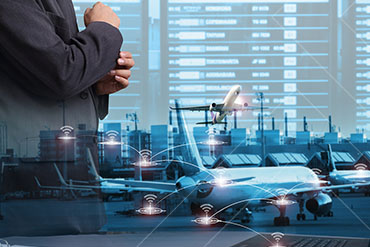
Airport 4.0: The Cognitive Era Takes Flight
The future airport will be about moving not waiting. When passengers arrive at the airport, they will get a seamless, zero-queue, customised experience that enables more time to explore the airport’s shops, restaurants and entertainment options. Beyond the passenger journey, the cognitive era will usher in improvements in efficiency and safety and provide new revenue streams for operators.
A Connected, Seamless Journey
Gone are the days of long queues and paper boarding passes. The airports of tomorrow are embracing cutting-edge technology to enhance the entire travel experience. Facial recognition, biometric scans and AI-driven security checks will become the norm, making the journey from check-in to boarding gate smoother than ever, and reducing passenger queuing time by 30-40%.
A flight information board in Detroit Metropolitan Airport, for example, uses futuristic technology to simultaneously show different travelers personalized information about their flight. Dubbed "Parallel Reality“, the screen uses non-biometric object detection and “multi-view pixels” to display personalized flight information to up to 100 travelers.
Integrated travel apps that manage the end-to-end journey will enable personalized services and targeted promotions. Personalized baggage options from home to destination will mean that passengers are unencumbered by luggage and are able to explore the retail and entertainment options at the airport more easily. For airports, these commercial activities will enable new revenue streams such as click and collect, or virtual gaming and movie theatres. Reducing baggage drop-off and security queues will also open up terminal space for even more retail and entertainment offerings, freeing up approximately 15-20% of airport real estate.
More Diverse Customers
Future airports will have more diverse customers in terms of age, physical ability and culture. By 2040, the MEAP region will account for 40% of global air passenger demand and by 2045, Asia-Pacific will surpass North America in passenger traffic. This demand will enable access to new destinations and tier-2 city to tier-2 city direct journeys. As the global population ages, airports are adapting to ensure a comfortable travel experience for seniors. This will include elements such as touchless technology and smart signage to aid those with mobility or sensory impairments. Terminals will be designed with easy navigation in mind, minimizing long walks and standing, reducing physical strain. Other technologies to assist ageing travelers could include autonomous wheelchairs and augmented reality wayfinding.
The tourism segment is also becoming more diverse with more micro personas such as solo travelers, experience seekers, social media influencers and other contemporary tourists. Global spending by travelers combining business with leisure (bleisure) will more than double between 2021 and 2027.
Cognitive Airports
The expanding use of IoT networks, 5G, data analytics and AI will enable the shift from Airport 2.0 to Airport 4.0 and beyond. Airport 2.0 includes the introduction of automation of processes and data-backed analysis, with the introduction of self-service and automated gates. Airport 3.0 has more advanced automation with real-time monitoring and predictive analytics. Airport 4.0 describes an airport with fully autonomous operations and AI/ML backed decision-making that is fully connected to all stakeholders. One major area for AI is airport security, including security screening such as real-time video analysis, biometric screening and behavioral prediction.
Changi airport, for example, is implementing an automated immigration checkpoint using passengers’ biometric data. Passengers will have a facial scan that verifies their identity at various touchpoints, reducing the need to repeatedly present travel documents. This also tackles the problem of processing increasing volumes of passengers combined with a skills shortage. In the near future, it is likely that physical passports will be completely eliminated.
This shift to cognitive airports will also impact the nature of jobs. Autonomous cleaning, maintenance and customer service will free up human workers for more complex tasks, such as AI programming, robotics engineering and personalised passenger service. We will see continuous training for airport workers to adapt to changing technologies and procedures. So, get ready to share the terminal with robotic companions! We will encounter many cognitive assistants, from self-driving luggage carts to autonomous delivery robots to robotic cleaners and translators.
Multimodal Hubs
The transformation of airports into dynamic, multimodal mobility hubs will see a significant increase in footfall, driving revenue growth in non-aeronautical revenue. To become multi-modal hubs, airports must enable seamless transfers between diverse travel modes and become part of a passenger-centric mobility system. The future airport will not just be a gateway; it will be a hub where terrestrial and airborne technologies converge. Picture a future integrating driverless vehicles, autonomous flying taxis and high speed hyperloop terminals. Airports can utilise core skills, available land and existing assets to incorporate Vertiports, which will enable new revenue streams from the urban air mobility market. These hubs are part of the aerotropolis model which will turn airports into destinations, shifting their role from merely departure points for flights to a places with their own attractions.
For example, Volocopter, which is looking to launch electric air taxi services during the 2024 Olympic Games in Paris, has set up test vertiports at select airports with a view to full airport integration in the future.
Revenue Shift:
Up to now, the transformation of non-aeronautical revenue (NAR) has been slow. While the core business for airports will remain passenger services and operations, as they embrace technological and environmental trends, there will be new sources of NAR. Some of these include the integration of virtual and e-commerce, urban air mobility services, multimodal connectivity, hydrogen hubs and electric vehicle charging services. By 2040, we expect NAR to account for 43% of total revenue.
Gatwick Airport, for example, has opened an Electric Forecourt, where all charging bays are powered by 100% net zero energy. Features include high-speed Wi-Fi, a lounge area, coffee shop and convenience store. It also has an interactive EV experience area to gain advice on EVs and take the opportunity to test drive an EV.
Net-Zero Airports
The future is not just about getting there; it's about getting there responsibly. Airports are transforming into green oases, with vertical gardens, solar panels, and innovative waste management systems. For example, green walls are being implemented to reduce temperature and improve air quality, while electric ground vehicles are cutting carbon emissions. Airports could also become green hydrogen hubs, where the lo-location of production will provide hydrogen for airport vehicles, airport energy demand and future hydrogen-powered aircraft. There are currently 12 members of the international "Hydrogen Hub at Airport" network, which promotes the further expansion of hydrogen infrastructure in aviation.
80% of the Forbes Global 2000 B2B companies rely on MarketsandMarkets to identify growth opportunities in emerging technologies and use cases that will have a positive revenue impact.
- Leading Automated Guided Vehicle Companies 2024: An In-depth Analysis
- CHARGED UP: SHIFT TO E-MOBILITY AND THE EVOLUTION OF TRANSPORTATION
- Global Automotive Market: Predictions For 2024
- Revolutionizing Depot Charging: Hockey Stick Growth on the Cards
- The Future of Silicon Battery Industry: Innovations and Market Outlook
Conclusion
This is just the beginning. As we move towards an autonomous world (a $10 trillion opportunity) we will see more automation in airport operations. Airports of the future will immerse us in an unparalleled travel experience where efficiency, personalization, and sustainability converge.


